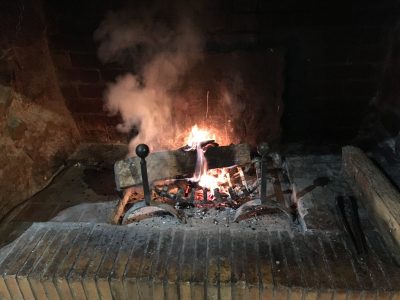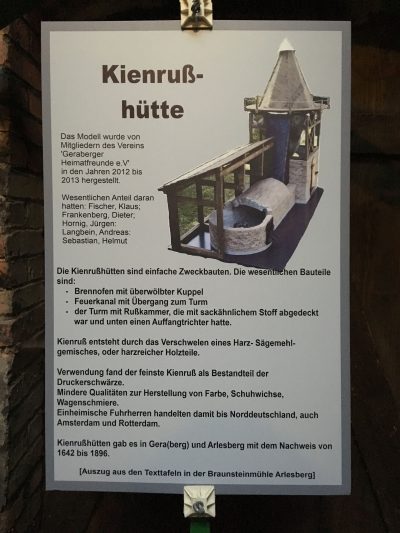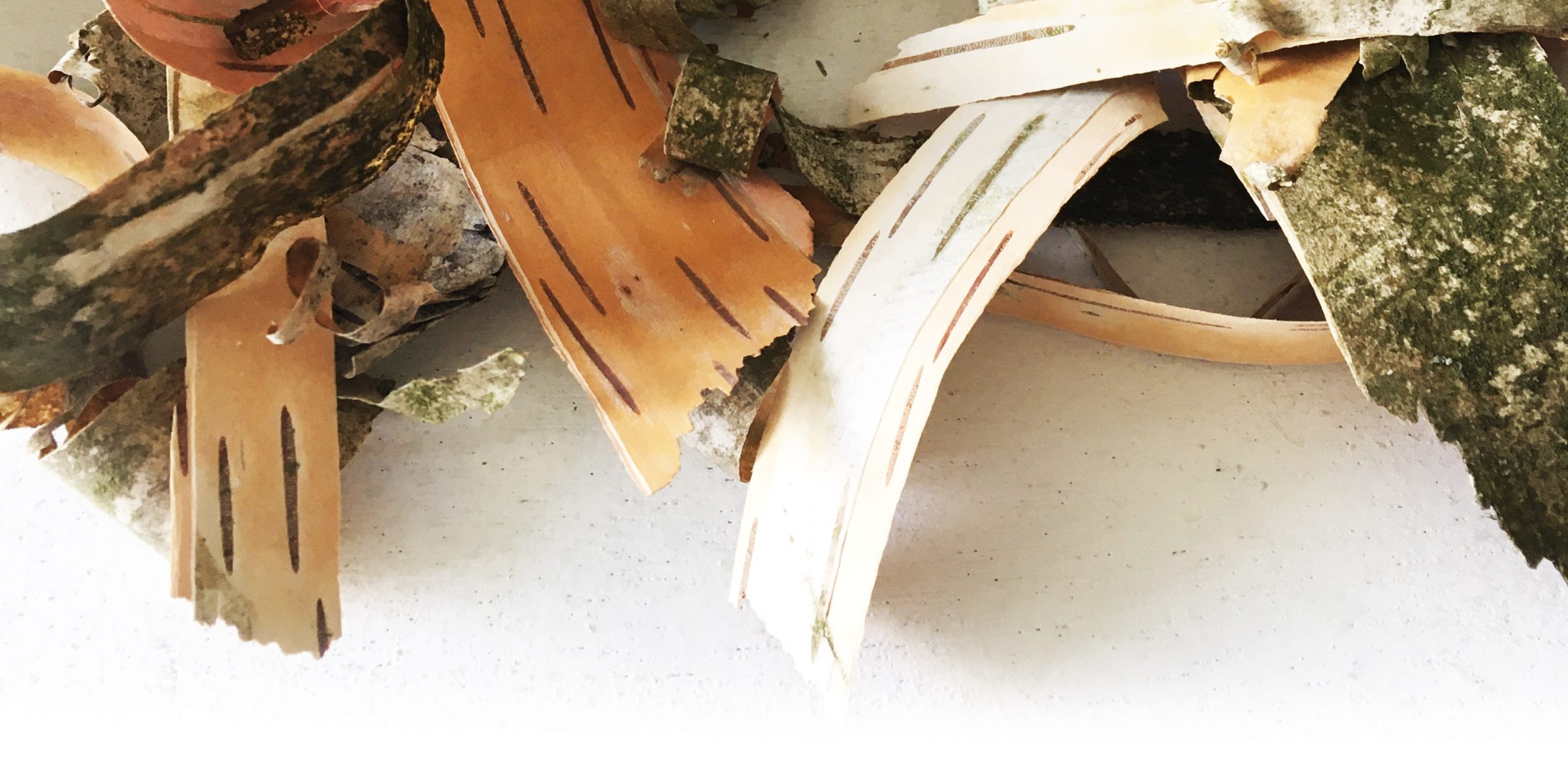
Wood-burning fires are the most ancient source of heat and light. Soot precipitates on hearth walls, in chimneys and on cauldrons and originates usually of various sorts of wood. Depending on the circumstances, the obtained soot can feature a variety of shades and properties, ranging from purest, finest black carbon particles to brown glossy lumps.
Soot on cauldrons Figure 8 Quote 4 / Recipe 4
“Jtem wiltu schwartz farw / temperiren ze entwerffen / oder zemālen So nim / linden rom der an eim / kessel wachs oder ainem / rochloch oder wie der / rom ist das er lind vnd / gutt sy vnd clain geriben.” [1],[2]

Soot that deposits externally on cauldrons was an easy and cheap supply of a black color. Hence it is not surprising that the use of “soot that grows on a cauldron or at a smoke-hole” is proposed in the above cited manuscript from Southern Germany.
Soot on fireplace walls and chimneys, bister (caligo, fuligo, bitter) Figures 9a, 9b / NO Quote / NO Recipe (no primary source available) / Color sample 1 / RECONSTRUCTION
“Vom gereinigten Ruß. Wenn du aber gereinigten Ruß machen willst, dann nimm von den kleinen braunen Rußknollen so viel du willst und lege sie in Lauge und laß sie um ein Drittel einkochen und laß den Topf dann zugedeckt stehen, dann fallen die Verunreinigungen alle zu Boden und das obenstehende Wasser hat eine schöne feine Haarfarbe, worauf man sie auch aufstreicht. Und wenn man das Wasser gebrauchen will, dann gieße so viel du benötigst aus dem Topf und gib Gummi dazu, so daß die Farbe glänzend wird. Und streiche das auf, worauf du willst und schattiere damit Gewänder oder Steingebirge, denn sie ist gut zum Malen vieler Dinge und zu mancherlei Schattierung.”[3]

Soot and the various side products of incomplete combustion deposit on the side walls of hearths and fireplaces. Also, they precipitate as hard, glossy clumps within chimneys which pose a fire hazard and therefore have to be removed regularly by the chimney sweeper. The first mention of bister is usually ascribed to le Begues’ manuscript of 1431, where it is included in his table of synonyms as caligo and fuligo.[4] Yet other earlier sources mention the use of “small brown lumps of soot”.[5]
The composition of bister depends on the type of wood that was burnt and can differ considerably.[6] Beside carbon particles, bister contains many brown-colored organic contaminants, which are the reason that bister is usually of a blackish-brown color, which can tend even towards intense brown, or orange-brown shades. Le Begue even referred to a “dark saffron yellow” color.[7]
Bister from resin-rich softwood leaves glossy residues on fireplace walls, hence the German name Glanzruß (Fig. 9a). These glossy tar-related, resinous substances are poorly soluble in water, properties that were undesirable for watercolors, as Ruffach warns in 1549.[8] Bister has a characteristic smoke smell reminiscent of a campfire.
Some early recipes, as for instance the quoted one, prescribe to ‘purify’ the bister by washing it in lye and concentrating the solution by boiling it down. Impurities sink to the bottom and the remaining solution can be used. Other authors advise to add water and let it ‘sieden up die helfte’ (boil down to half) and finally add some alum.[9] Bister was attributed a healing effect, therefore, the material was sold in pharmacies, as a late fifteenth-century illustration of Fuligo in the Circa Instans, seu de medicamentis simplicibus by Plaetarius depicts (Figure 9b). Bister is especially recommended for painting hair and beards.[10]
Soot of conifer wood (Lampblack) Figure 10a Quote 5 / No recipe / Color sample 2, Color sample 3

“Kün schwartz ist jederman bekant”[11]
Burning wood of coniferous trees provides another sort of soot, in German sources referred to as Kienrußschwarz or Kienschwarz. The English term lampblack literally refers to soot of (oil)lamps, but misleadingly became widely established as the common name for the soot of conifer wood.[12] The wood of coniferous trees contains a large amount of resins which makes it suitable as tinder, but also rendering a quite beautiful soot-black. After 1450, when printing with movable metal types was invented, lampblack became the principal soot-related black pigment because it was suited perfectly for book-printing ink. The forest-rich region of Thuringia in Central Germany and later also Scandinavia[13] became the major producers of lampblack.

Kienruß-furnaces were built by the side of pitch furnaces directly in forest areas in order to avoid the laborious transport of wood and effectively use up the wastes of pitch production. All conifer wood parts that could not be used otherwise, like roots, barks, needles, stumps etc., were used as raw material for the production of lampblack. German Kienruß-furnaces had a special design to separate fractions of soot differing in quality. These furnaces were able to produce very pure soot of high quality as well as of lower qualities (Fig. 10b). Krünitz makes an interesting remark when discussing Chinese ink production. He emphasizes the marvelous quality of black soot from burning spruce wood, which interestingly is also the major source of Kienruß production in Thuringia.[14]
The poor families of the Thuringian forest regions earnt a bit extra by fabricating chip-wood boxes made of fir-wood with a sliding lit for packing smaller quantities of lampblack.[15] Larger quantities were sold in vats of differing size.[16] Traded all over Europe in large quantities, lampblack came in different qualities. The best quality was used in typography as book printing ink and consisted of finest pure carbon particles and therefore had an intense black color and a vast covering power. Lower qualities could contain larger soot particles or even bister-like residues and were used by shoemakers and house-painters. Yet lower qualities were used in the ship industry for coating ship hulls. Therefore, the major sales markets of the Thuringian carbon black manufacturers were Great Britain and the Netherlands, who, besides the low qualities, were also in need of good black pigment for their book printing centers.
Even before mass production started around the beginning of the seventeenth century, lampblack was already a well-known pigment. In the mid-sixteenth century it was so commonplace, that Boltz van Ruffach, who extensively discussed several black pigments in his Illuminier Buoch (1549), dedicated just one sentence to this pigment: “Kün schwartz ist jederman bekant”. It was already mentioned as a pigment for the preparation of black wax in the Liber illuministarum (1450/ 1500-1512) [17] and was most probably at the disposal of Burgundian illuminators who might have appreciated its special properties.

Soot of birch bark Figures 11a, 11b Quote 6 / Recipe 5 / RECONSTRUCTION
“Wer aber das du des romß nit fȗndest, so nime birkin rinden vnd brenn sy an aim fȗr vnd stu̇rtz ain bekin darȗber oder ain glest kachel, das der tunst daruff mutt gon und der rom der daran wachst, der ist recht gutt.” [18]
Some types of hardwood also contain resins, like beech (genus Fagus) or birch (genus Betula).[19] Birch bark is a natural tinder because it burns perfectly due to its paper-thin structure and its resin content (Fig. 11b). The author of the cited Swabonian manuscript was aware that it renders good black soot when he noted around 1450: “But if you don’t find any soot, take birch bark and burn it in a fire and cover this with a small pot or a glazed earthenware vessel, so the smoke must touch it. The soot that grows on it is quite good.” Reconstructions showed that birch bark burns instantly, with a strong smoke development. In some cases, glossy, resinous products deposited with the birch bark soot.
[1] “Item If thou like to temper a black paint for designing or painting. Take soft soot that grows on a cauldron or smoke hole [chimney], or other soot that is soft and good, and grind it.” Codex Germanicus 1. 1454-1463. Hamburg, Staats-und Universitätsbibliothek, Cod. Germ. 1: fol. 73r. Transcription in: Heiles. 2018. Die Farb- und Tintenrezepte des Cod. germ. 1: p. 13-61.
[2] Translations into English are, unless otherwise stated, by B. Reissland.
[3] “From the cleaned soot. But if you want to make cleaned soot, then take as much of the small brown soot lumps as you want and put them in lye and let them boil down by a third and then leave the pot covered, then the impurities will all fall to the bottom and the water above has a beautiful fine hair color, which you can also brush on. And when you want to use the water, pour as much as you need out of the pot and add gum so that the color becomes shiny. And paint whatever you want and use it to shade garments or stone mountains, because it is good for painting many things and for various shading.” Haller. 1478. Berner Farbrezepte, Colmarer Kunstbuch, Bern, Burgerbibliothek, Cod. Hist. Helv. XII 45: 130-131. Transcript and normalized version in: Oltrogge, Datenbank mittelalterlicher und frühneuzeitlicher kunsttechnologischer Rezepte in handschriftlicher Überlieferung, FH Köln, Institut für Restaurierungs- und Konservierungswissenschaften. Available at: https://db.cics.th-koeln.de/start.fau?& (acc. 13.02.2020, lemma ‘Russ”)
[4] Le Begue. 1431. BnF MS Latin 6741: fol. 6v, table of synonyms.
[5] Strassbourg manuscript. 1400-1412: recipe 50. In: Neven. 2016. The Strasbourg Manuscript: p. 115.
[6] Reissland and Smulders. 2020. Bistre / Glanzruss: GC-MS analysis of components, Research Report No. 2020-070.
[7] Le Begue. 1431. BnF MS Latin 6741: fol. 4v, table of synonyms.
[8] Boltz von Ruffach. 1549. Illuminier Buoch: p. xlv-xlvi.
[9] Braekman. 1997. Warenkennis, Kleurbereidingen Voor Miniaturisten En Vakkennis Voor Ambachtslui (15de E.): p. 138, rec. 35.
[10] Reissland. 2021. Black Color Technologies for Illuminators, 1350-1700. LINK
[11] “Pine-soot black is known to everyone.” Boltz von Ruffach. 1549. Illuminier Buoch: p. 98
[12] Another ‘lampblack’ was sold under the same name, but was produced by burning resin, not wood (see, soot of coniferous resins, noire de Paris).
[13] According to Krünitz, Sweden joint in the lampblack trade as late as 1651. Krünitz. 1820. Oekonomisch-Technologische Encyklopädie, Vol. 128: p. 738.
[14] “Spruce is a most exquisite wood, which is especially consumed for this purpose in China because of the beautiful blackness which it yields when it is burned. There are immense forests of this type of wood in China, especially in the district of the city of Hoei = tcheou in the province of Klangnan.” As Krünitz describes, the Chinese also had specially built ovens for the production of soot from resinous wood. In: Krünitz. 1820. Oekonomisch-Technologische Encyklopädie, Vol. 128: p. 732.
[15] Hartwig and Rosenthal, eds. 1793. Technologisches Wörterbuch oder alphabetische Erklaerung aller nuetzlichen mechanischen Kuenste, Manufakturen, Fabriken und Handwerker: p. 252.
[16] The mass-production in Thuringia continued in the nineteenth century and reached 250 000 vats just from one village, Elgersburg. See: Sachsen-Coburg-Gotha, Statistisches Bureau. 1866. Mittheilungen aus dem Statistischen Büreau des Herzogl. Staats-Ministeriums zu Gotha über Landes- und Volkskunde, besonders bezüglich des Herzogthums Gotha. 2. Theil, 3. Heft: p. 720.
[17] Liber illuministarum. 1450 / 1500-1512. Munich, Staatsbibliothek, MS. Germ. 821: fol. 93r. In: Bartl et al. 2005. Der “Liber illuministarum“ aus Kloster Tegernsee:: 154-155.
[18] “But if you don’t find any soot, take birch bark and burn it in a fire and cover this with a small pot or a glazed earthenware vessel, so the smoke must touch it. The soot that grows on it is quite good.” In: Codex Germanicus 1. 1454-1463. Hamburg, Staats-und Universitätsbibliothek, Cod. Germ. 1: fol. 73r. also in: Heiles (2018): p. 13-61.
[19] Birch tar, extracted from birch bark, was fabricated as early as the Middle Pleistocene, when it was used as an adhesive. See Mazza et al. 2006. A New Palaeolithic Discovery: Tar-Hafted Stone Tools in a European Mid-Pleistocene Bone-Bearing Bed: p. 1310–18.
[1] “Item If thou like to temper a black paint for designing or painting. Take soft soot that grows on a cauldron or smoke hole [chimney], or other soot that is soft and good, and grind it.” Codex Germanicus 1. 1454-1463. Hamburg, Staats-und Universitätsbibliothek, Cod. Germ. 1: fol. 73r. Transcription in: Heiles. 2018. Die Farb- und Tintenrezepte des Cod. germ. 1: p. 13-61.
[1] “Item If thou like to temper a black paint for designing or painting. Take soft soot that grows on a cauldron or smoke hole [chimney], or other soot that is soft and good, and grind it.” Codex Germanicus 1. 1454-1463. Hamburg, Staats-und Universitätsbibliothek, Cod. Germ. 1: fol. 73r. Transcription in: Heiles. 2018. Die Farb- und Tintenrezepte des Cod. germ. 1: p. 13-61.
[4] Le Begue. 1431. BnF MS Latin 6741: fol. 6v, table of synonyms.
[4] Le Begue. 1431. BnF MS Latin 6741: fol. 6v, table of synonyms.
[6] Reissland and Smulders. 2020. Bistre / Glanzruss: GC-MS analysis of components, Research Report No. 2020-070.
[7] Le Begue. 1431. BnF MS Latin 6741: fol. 4v, table of synonyms.
[8] Boltz von Ruffach. 1549. Illuminier Buoch: p. xlv-xlvi.
[9] Braekman. 1997. Warenkennis, Kleurbereidingen Voor Miniaturisten En Vakkennis Voor Ambachtslui (15de E.): p. 138, rec. 35.
[9] Braekman. 1997. Warenkennis, Kleurbereidingen Voor Miniaturisten En Vakkennis Voor Ambachtslui (15de E.): p. 138, rec. 35.
[11] “Pine-soot black is known to everyone.” Boltz von Ruffach. 1549. Illuminier Buoch: p. 98
[12] Another 'lampblack' was sold under the same name, but was produced by burning resin, not wood (see, soot of coniferous resins, noire de Paris).
[13] According to Krünitz, Sweden joint in the lampblack trade as late as 1651. Krünitz. 1820. Oekonomisch-Technologische Encyklopädie, Vol. 128: p. 738.
[13] According to Krünitz, Sweden joint in the lampblack trade as late as 1651. Krünitz. 1820. Oekonomisch-Technologische Encyklopädie, Vol. 128: p. 738.
[15] Hartwig and Rosenthal, eds. 1793. Technologisches Wörterbuch oder alphabetische Erklaerung aller nuetzlichen mechanischen Kuenste, Manufakturen, Fabriken und Handwerker: p. 252.
[16] The mass-production in Thuringia continued in the nineteenth century and reached 250 000 vats just from one village, Elgersburg. See: Sachsen-Coburg-Gotha, Statistisches Bureau. 1866. Mittheilungen aus dem Statistischen Büreau des Herzogl. Staats-Ministeriums zu Gotha über Landes- und Volkskunde, besonders bezüglich des Herzogthums Gotha. 2. Theil, 3. Heft: p. 720.
[16] The mass-production in Thuringia continued in the nineteenth century and reached 250 000 vats just from one village, Elgersburg. See: Sachsen-Coburg-Gotha, Statistisches Bureau. 1866. Mittheilungen aus dem Statistischen Büreau des Herzogl. Staats-Ministeriums zu Gotha über Landes- und Volkskunde, besonders bezüglich des Herzogthums Gotha. 2. Theil, 3. Heft: p. 720.
[18] "But if you don't find any soot, take birch bark and burn it in a fire and cover this with a small pot or a glazed earthenware vessel, so the smoke must touch it. The soot that grows on it is quite good." In: Codex Germanicus 1. 1454-1463. Hamburg, Staats-und Universitätsbibliothek, Cod. Germ. 1: fol. 73r. also in: Heiles (2018): p. 13-61.
[18] "But if you don't find any soot, take birch bark and burn it in a fire and cover this with a small pot or a glazed earthenware vessel, so the smoke must touch it. The soot that grows on it is quite good." In: Codex Germanicus 1. 1454-1463. Hamburg, Staats-und Universitätsbibliothek, Cod. Germ. 1: fol. 73r. also in: Heiles (2018): p. 13-61.